Bacterial conjugation is a gene transfer mechanism introduced by the scientists named Lederberg and Tatum in 1946. The conjugation method was first studied in Escherichia coli. The formation of a conjugation tube is the characteristic feature of a conjugation mechanism.
Besides transduction and transformation mechanisms, some bacteria passes the genetic information from a donor to a recipient cell via the cytoplasmic bridge, what we call the “Conjugation tube”.
Pilus or conjugation tube refers to the condition in which a bridge forms between the bacterial cells (donor and recipient cell). The bridge serves as a passage in transferring the genetic material. In this context, we will discuss the meaning, mechanism and methods of bacterial conjugation.
Content: Bacterial Conjugation
Meaning of Bacterial Conjugation
Bacterial conjugation refers to a process in which a donor cell (having fertility factor) associates with a recipient cell by forming a protuberance called a conjugation tube. The genetic material passes from one cell to another through the conjugation tube.
A donor or F+ cell tends to form a conjugation tube through the self-transmissible F-plasmid in a conjugation process. The F-plasmid stands for fertility plasmid that commonly exists in gram-positive and negative bacterial cells.
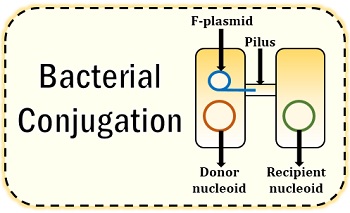
A recipient or F– cell takes one strand of the F-plasmid from the donor cell and becomes “Transconjugant”. The transfer mechanism in bacterial conjugation occurs between the known or intraspecific species. Some bacteria possess promiscuous plasmid that allows genetic exchange within the unrelated species.
F-Plasmid
It also refers to the fertility factor, which is the combination of three elements:
- Loci gene: A fertility plasmid comprises mainly two loci, namely tra and trb genes. A transacting or tra gene contains the genome DNA, which encodes the proteins forming a channel for transferring DNA. Trb gene encodes the proteins associated with the processes like:
-
- Cell to cell contact: Encodes protein that helps in forming pili around the cell.
- Cell attachment: Encodes protein that helps in the binding of donor bacterium to the recipient bacterium.
- Transfer: Encodes protein that initiates the exchange of chromosomal DNA.
- OriT: It is an acronym of Origin of transfer. OriT functions as an active site during the migration of chromosomal DNA from a donor bacterium to a recipient bacterium.
- OriV: It is a site for the replication of chromosomal DNA, which occurs independently.
Mechanism of Bacterial Conjugation
The mechanism of conjugation includes the following steps:
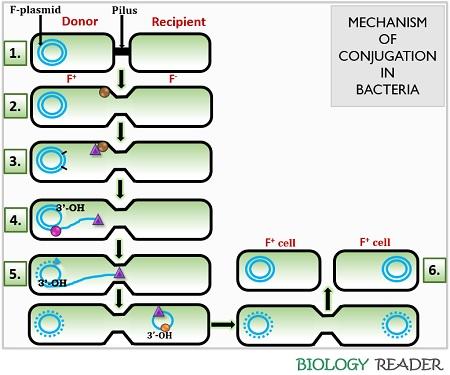
- Mating pair formation: A donor cell possesses a self-transmissible plasmid that facilitates the formation of pilus. A pilus unites a donor cell with the recipient bacterial cell.
- Signalling by coupling protein: Coupling protein complex is a component of Mpf or mating pair formation complex. It provides a signal to create a cut in the chromosomal DNA by activating the relaxase enzyme.
- Relaxase activation: Relaxase activates and associates with the OriT site of the bacterial chromosomal DNA and facilitates strand displacement.
- Chromosomal DNA strand separation: An enzyme helicase helps in detaching the chromosomal DNA fragment.
- Plasmid DNA transfer recyclization and replication: The plasmid DNA moves to the recipient cell along with the primase enzyme (attached to the free hydroxyl 3’ prime). It plays no functional role in the conjugation process.
- Mating pair separation: Finally, the donor and recipient cell detach from one another.
Methods of Conjugation
Bacterial conjugation occurs via three methods:
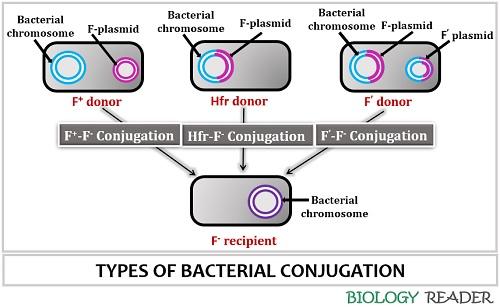
- F+-F– Conjugation
- Hfr-F– Conjugation
- F’-F– Conjugation
F+-F– Conjugation
This kind of conjugation occurs between the donor cell having fertility factor or F+ and the recipient cell that lacks such factor or indicated as F–. F-plasmid refers to the fertility factor that functions in the expression of pilus, synthesis and exchange of plasmid DNA during mating. The role of fertility factor is controlled by the cluster of 25 tra genes, which is broadly classified into two types:
- Mpf: It is an acronym of the term Mating pair formation. Mpf genes hold the mating cells together and provide a passage for the DNA and protein transfer through pilus and some channels, respectively.
- Dtr: It is an acronym for the term DNA transfer and replication. Dtr is a gene product engaged in the processing and transferring of plasmid DNA.
The F-pili of the donor cell initiates the process of mating by first binding with the outer membrane protein of the recipient cell. Eventually, a cytoplasmic bridge appears between the F+ and F– cell, which commonly refers to the conjugation tube or pilus.
A relaxase enzyme creates a nick in one strand of the F-plasmid at the oriT site through this cytoplasmic bridge. The nicked strand moves to the recipient cell from 5’-3’ prime.
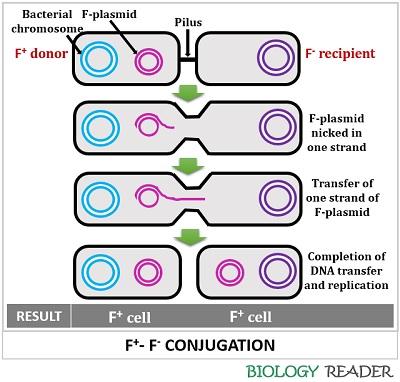 OriT refers to the site where the transfer of plasmid DNA occurs. Thus, a pilus formed between the F+ and F– cell facilitates the transfer of F-plasmid DNA.
OriT refers to the site where the transfer of plasmid DNA occurs. Thus, a pilus formed between the F+ and F– cell facilitates the transfer of F-plasmid DNA.
The single stranded DNA moves into the recipient cell, which later transforms into the circular F-plasmid ds-DNA. After the completion of conjugation, both the partners would carry F-plasmid DNA.
Hfr-F– Conjugation
It merely refers to the mating between the high-frequency recombination and F– strains. Hfr strains possess F-plasmid integrated with the bacterial chromosome. An Hfr strain will function as a donor cell, passing the chromosomal genes to the F– strain.
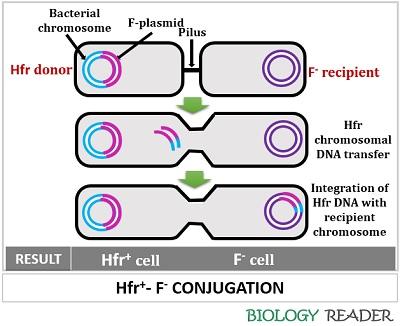 One strand of the chromosomal DNA from the Hfr strain will move to the recipient cell from the origin of the transfer site. Unlike conjugation between F+-F– strain, it involves the transfer of a full bacterial chromosome and a part of F-plasmid from the Hfr donor to the F– strain.
One strand of the chromosomal DNA from the Hfr strain will move to the recipient cell from the origin of the transfer site. Unlike conjugation between F+-F– strain, it involves the transfer of a full bacterial chromosome and a part of F-plasmid from the Hfr donor to the F– strain.
In contrast to F+-F– strain conjugation, only a part of F-plasmid is transferred that would not cause F+ strain transformation into F+ strain. The replicated donor DNA enters the recipient cell and may degrade into fragments.
The fragmented DNA incorporates with the recipient’s nucleoid via recombination. Hfr-F– Conjugation is a relatively important process that helps to study the mechanism of gene mapping. The relative positions of the genes in a bacterial chromosome can also be identified.
F’-F– Conjugation
Here, mating occurs between the F’ and F– strains. F’– strain contains excised F-plasmid integrated with the chromosomal DNA of the Hfr strain. F– Strain only contains the bacterial nucleoid and functions as a recipient cell.
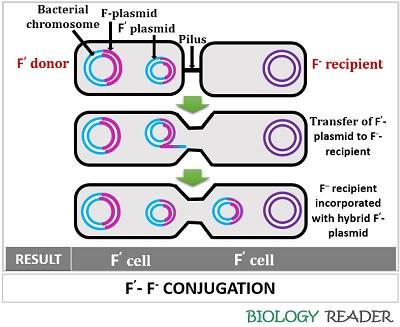 This kind of conjugation is virtually identical, where the F’ plasmid enters the F– strain without being incorporated into the recipient’s nucleoid. Therefore, a recipient cell becomes an F’– strain and functions as a partially diploid merozygote by carrying an F’– plasmid or possessing two sets of genes.
This kind of conjugation is virtually identical, where the F’ plasmid enters the F– strain without being incorporated into the recipient’s nucleoid. Therefore, a recipient cell becomes an F’– strain and functions as a partially diploid merozygote by carrying an F’– plasmid or possessing two sets of genes.